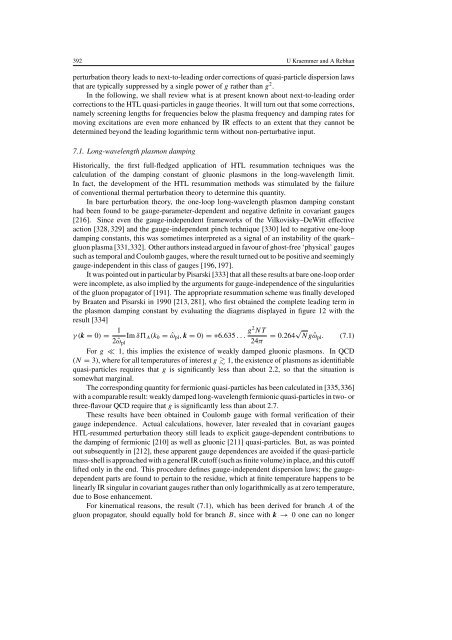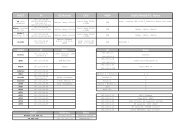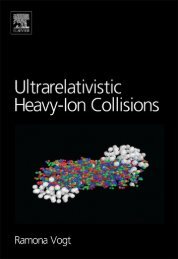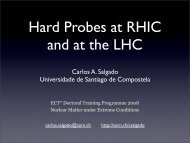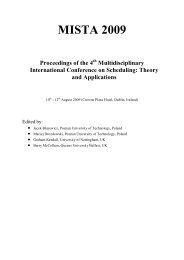Advances in perturbative thermal field theory - Ultra-relativistic ...
Advances in perturbative thermal field theory - Ultra-relativistic ...
Advances in perturbative thermal field theory - Ultra-relativistic ...
You also want an ePaper? Increase the reach of your titles
YUMPU automatically turns print PDFs into web optimized ePapers that Google loves.
392 U Kraemmer and A Rebhan<br />
perturbation <strong>theory</strong> leads to next-to-lead<strong>in</strong>g order corrections of quasi-particle dispersion laws<br />
that are typically suppressed by a s<strong>in</strong>gle power of g rather than g 2 .<br />
In the follow<strong>in</strong>g, we shall review what is at present known about next-to-lead<strong>in</strong>g order<br />
corrections to the HTL quasi-particles <strong>in</strong> gauge theories. It will turn out that some corrections,<br />
namely screen<strong>in</strong>g lengths for frequencies below the plasma frequency and damp<strong>in</strong>g rates for<br />
mov<strong>in</strong>g excitations are even more enhanced by IR effects to an extent that they cannot be<br />
determ<strong>in</strong>ed beyond the lead<strong>in</strong>g logarithmic term without non-<strong>perturbative</strong> <strong>in</strong>put.<br />
7.1. Long-wavelength plasmon damp<strong>in</strong>g<br />
Historically, the first full-fledged application of HTL resummation techniques was the<br />
calculation of the damp<strong>in</strong>g constant of gluonic plasmons <strong>in</strong> the long-wavelength limit.<br />
In fact, the development of the HTL resummation methods was stimulated by the failure<br />
of conventional <strong>thermal</strong> perturbation <strong>theory</strong> to determ<strong>in</strong>e this quantity.<br />
In bare perturbation <strong>theory</strong>, the one-loop long-wavelength plasmon damp<strong>in</strong>g constant<br />
had been found to be gauge-parameter-dependent and negative def<strong>in</strong>ite <strong>in</strong> covariant gauges<br />
[216]. S<strong>in</strong>ce even the gauge-<strong>in</strong>dependent frameworks of the Vilkovisky–DeWitt effective<br />
action [328, 329] and the gauge-<strong>in</strong>dependent p<strong>in</strong>ch technique [330] led to negative one-loop<br />
damp<strong>in</strong>g constants, this was sometimes <strong>in</strong>terpreted as a signal of an <strong>in</strong>stability of the quark–<br />
gluon plasma [331,332]. Other authors <strong>in</strong>stead argued <strong>in</strong> favour of ghost-free ‘physical’ gauges<br />
such as temporal and Coulomb gauges, where the result turned out to be positive and seem<strong>in</strong>gly<br />
gauge-<strong>in</strong>dependent <strong>in</strong> this class of gauges [196, 197].<br />
It was po<strong>in</strong>ted out <strong>in</strong> particular by Pisarski [333] that all these results at bare one-loop order<br />
were <strong>in</strong>complete, as also implied by the arguments for gauge-<strong>in</strong>dependence of the s<strong>in</strong>gularities<br />
of the gluon propagator of [191]. The appropriate resummation scheme was f<strong>in</strong>ally developed<br />
by Braaten and Pisarski <strong>in</strong> 1990 [213, 281], who first obta<strong>in</strong>ed the complete lead<strong>in</strong>g term <strong>in</strong><br />
the plasmon damp<strong>in</strong>g constant by evaluat<strong>in</strong>g the diagrams displayed <strong>in</strong> figure 12 with the<br />
result [334]<br />
γ(k = 0) = 1 Im δ A (k 0 =ˆω pl , k = 0) = +6.635 ... g2 NT<br />
2 ˆω pl 24π = 0.264√ Ng ˆω pl . (7.1)<br />
For g ≪ 1, this implies the existence of weakly damped gluonic plasmons. In QCD<br />
(N = 3), where for all temperatures of <strong>in</strong>terest g 1, the existence of plasmons as identifiable<br />
quasi-particles requires that g is significantly less than about 2.2, so that the situation is<br />
somewhat marg<strong>in</strong>al.<br />
The correspond<strong>in</strong>g quantity for fermionic quasi-particles has been calculated <strong>in</strong> [335,336]<br />
with a comparable result: weakly damped long-wavelength fermionic quasi-particles <strong>in</strong> two- or<br />
three-flavour QCD require that g is significantly less than about 2.7.<br />
These results have been obta<strong>in</strong>ed <strong>in</strong> Coulomb gauge with formal verification of their<br />
gauge <strong>in</strong>dependence. Actual calculations, however, later revealed that <strong>in</strong> covariant gauges<br />
HTL-resummed perturbation <strong>theory</strong> still leads to explicit gauge-dependent contributions to<br />
the damp<strong>in</strong>g of fermionic [210] as well as gluonic [211] quasi-particles. But, as was po<strong>in</strong>ted<br />
out subsequently <strong>in</strong> [212], these apparent gauge dependences are avoided if the quasi-particle<br />
mass-shell is approached with a general IR cutoff (such as f<strong>in</strong>ite volume) <strong>in</strong> place, and this cutoff<br />
lifted only <strong>in</strong> the end. This procedure def<strong>in</strong>es gauge-<strong>in</strong>dependent dispersion laws; the gaugedependent<br />
parts are found to perta<strong>in</strong> to the residue, which at f<strong>in</strong>ite temperature happens to be<br />
l<strong>in</strong>early IR s<strong>in</strong>gular <strong>in</strong> covariant gauges rather than only logarithmically as at zero temperature,<br />
due to Bose enhancement.<br />
For k<strong>in</strong>ematical reasons, the result (7.1), which has been derived for branch A of the<br />
gluon propagator, should equally hold for branch B, s<strong>in</strong>ce with k → 0 one can no longer


